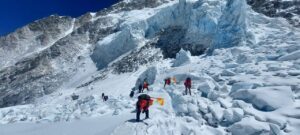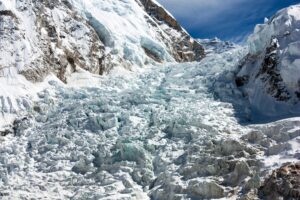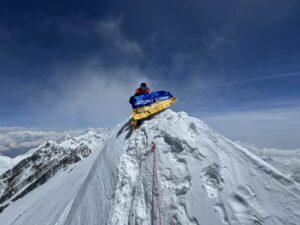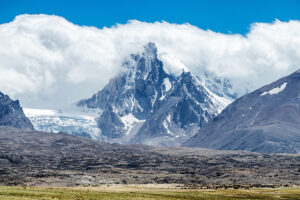The spring Himalayan season had ended, with decidedly mixed results. On the positive side, Marek Holecek and Radoslav Groh opened a new route alpine-style on the west face of Baruntse. They especially showed their mettle during the descent. The twosome endured four foodless days in a tiny bivouac tent when Cyclone Yaas hit and they couldn’t move.
Meanwhile, Slovak Peter Hamor and Romanians Horia Colibasanu and Marius Gane attempted a new route on Dhaulagiri’s Northwest Ridge, but retreated after surviving an avalanche that buried their tent as they slept.

The real deal: Marek Holecek and Radoslav Groh, high on Baruntse. Photo: Holecek/Groh
On the other hand, what happened on other mountains wasn’t so much mountaineering as business. It was all about marketing, project management, corporate public relations, and contingency plans.
High-altitude expectations
After a COVID-stricken 2020, recovery was the motto for this spring. Expectations were high. Climbers craved adventure and high-altitude glory. Outfitters, tourism businesses, and Nepali authorities were equally eager to squeeze the country’s rich natural resources, Everest above all.

In high-altitude tourism, higher is better. Luckily, Nepal has Everest. With China closed to foreign expeditions, Nepal’s side of the mountain was going to enjoy the whole tourism enchilada.
Optimizing profits
Big teams and their big money have prompted companies to up their game. They hire the most experienced Sherpa climbers, fly delicacies into base camps and high camps, and supply loads of oxygen.
For other 8,000’ers, the trick was to optimize costs by balancing lots of resources with lots of clients, focusing everything on one mountain at a time, and encouraging double-headers. But it was definitely not two for the price of one.
Out of the eight 8,000’ers in Nepal, climbers divided between Everest (with some also aiming for neighboring Lhotse) and Annapurna plus Dhaulagiri. Companies offered these two latter mountains as back-to-back targets. Big teams used the same fixed ropes and resources, and the same staff that worked Annapurna later moved to Dhaulagiri.
This is why the first climbers who reached Dhaulagiri in mid-April found the mountain quiet, with no fixed ropes or higher camps. The route-fixing team was still on its way there from Annapurna.

Annapurna Base Camp at night. Photo: Kamran on Bike
While Annapurna succeeded spectacularly, Dhaulagiri failed because of tough conditions and a COVID outbreak. Some Sherpa guides and a few clients then switched to Lhotse. Such triple headers have been possible thanks to the massive use of O2 and helicopter airlifts between Base Camps.
The COVID season
We never heard much about trekkers or climbers on lesser peaks. This was not a season for trekkers, anyway. The uncertainty about COVID and Nepal’s unclear, hesitant countermeasures put off nearly everyone with limited time and budgets.
On the other hand, climbers ready to spend a couple of months in the mountains could well afford to quarantine in Kathmandu for a few days. However, even those long quarantine requirements soon eased, under the pressure from outfitters — especially after it became clear that COVID or not, big-money clients were flocking in droves to Nepal.
And why not? Contagion rates in March were relatively low, the outdoors is a safe environment, and climbers could isolate themselves in their own team bubbles. This had worked on winter K2, so why not here?

Large teams such as India’s CAFP gathered in Everest Base Camp. Photo: Seven Summit Treks
Well, for two main reasons. First, a casualness toward the virus and faith in PCRs created a false sense of security. Second, local guides and staff with the expeditions had few or no safety guidelines. They moved freely between Kathmandu and the mountains and often visited friends and relatives downvalley before returning to BC.
Many young Nepalis also work abroad, and the permeable, 1,750km border with India combined to create a devastating COVID wave in Nepal. Soon, the quiet, healthy times of March were a distant memory.

The long line to the summit of Annapurna. Photo: Pasang Lamu Sherpa Akita
In mid-April, 68 Annapurna summiters and an unknown number of staff celebrated their success in Pokhara for several days. Most of them then traveled to Dhaulagiri. Several carried the virus. Soon, over 50 people tested positive, including a number of climbers who took part in a tentative summit push which actually ended in Camp 2.
Meanwhile at Everest, crew and clients started getting sick. They were all evacuated to a hospital in Kathmandu with a preliminary diagnosis of Acute Mountain Sickness. Doctors at the Himalayan Rescue Association field clinic were not allowed to run COVID tests, although a few international team leaders brought their own diagnostic tools.
Good news only
When the positives started coming in, both in Kathmandu and at BC, Nepal authorities simply denied the facts. Their main effort seemed to be to sustain a policy of secrecy that had started pre-season, with rules meant to deter sharing negative photos (eg. of summit crowds) on social media.
In 2021, Nepal’s Department of Tourism tried to issue as many climbing permits as possible while avoiding damaging news or images that could further taint the Everest brand.
Ultimately, they issued a record 408 permits, estimated at $4.2 million. That was a success. But silencing bad news proved impossible and even created a backlash.

An Icefall Doctor at Camp 2. Photo: SPCC
Nepal’s Department of Tourism launched an awkward set of rules, forbidding climbers to use drones and take pictures of anyone except their own team members. It also outlawed helicopter flights from BC to Kathmandu except in medical emergencies.
These rules were neither strictly enforced nor respected. So officials backed it up by threatening expedition leaders. Keep your troops in order, they said, or you might have trouble obtaining climbing permits in the future.
Ensued nothing but sunny, inspirational, Instagrammy reports notable for their absolute lack of information. This led to a fever-pitch of rumors and bitter, off-the-record comments that I’ve never experienced in more than 20 years of mountain journalism.

Furtenbach Adventures performed COVID tests in Base Camp. Photo: Furtenbach Adventures
COVID beyond Base Camp
The main controversy this season was less about crowds and deaths (although both occurred) than COVID. More and more climbers ended up in the hospital in Kathmandu, and some eventually admitted to positive tests.
Some expedition groups, deeply concerned about the outbreak, abandoned their climb entirely. Later, they spoke freely about the real situation. It would have been almost laughable, if not for the tragedy the rest of the country was undergoing.
Further testimonies confirmed that several climbers went up to higher camps while sick. Sigurdur Sveinsson and Heimir Hallgrimsson showed symptoms on the way up but they still reached the top — and became seriously sick on the way down, according to the Voice of America.
Briton Simone Ferrier-May, after some confusing posts which suggested that he had summited with COVID, later explained that his symptoms transpired earlier in the month, and he wasn’t sure that they signaled COVID or not.
“It was highly likely to be COVID…[because] the two people I sat next to in the dining tent at Base Camp (who were also sick around the same dates) later flew to Lukla and tested positive,” he said.
Two weeks later, by which time he would presumably have recovered in any case, he summited Everest.
Scott Simper, climbing with Elia Saikaly’s film crew, did summit with COVID.

Erlend Ness, the first Everest climber to admit from his hospital bed in Kathmandu that he had COVID. Photo: Erlend Ness
While some teams did everything to avoid the virus by fencing in their camps, avoiding outside interactions, and being as cautious as possible, others sloppily tried to convey an image of normalcy by holding inter-team parties, despite the angry reaction when they shared the videos of Base Camp fun.
In particular, the increasingly powerful Nepali companies were keen to show their lack of concern for COVID, resorting to personal attacks on the journalists who reported it! Like Nepal itself, they wanted controlled-only news — in other words, pr — permitted on the mountain.
Chopper & O2 tactics
In addition to expanded Sherpa assistance and fixed ropes along the entire route, tactics included abundant oxygen cylinders and limitless use of helicopters. When the rope-fixing team on Annapurna discovered that they were short of rope, a helicopter bought a fresh supply, plus O2, right to Camp 4. The extra oxygen allowed clients to linger for two days in their tents at 7,000m while Sherpas put the additional ropes in place.

A helicopter evacuates more climbers from Everest Base Camp. Photo: SummitClimb
At its peak, between 1,500 and 2,000 people transformed Everest Base Camp into a small town. This included foreign climbers for Everest and Lhotse, plus friends, BC staff, porters, rope-fixing teams, and guides.
An army of helicopters flew up and down the Khumbu constantly to resupply this population. They went up to Camp 2, performed rescues, carried gear and supplies, and even shuttled some climbers not to keen to tackle the Khumbu Icefall.

Sherpas carry O2 canisters down the mountain.
When two cyclones in a row hit the Indian subcontinent and its winds and moisture reached Everest, climbers continued to wait confidently in Camp 2, knowing that plenty of oxygen was available, even if they wanted to begin using it that low down, from 6,400m to the summit.
Breathing easier
New O2 systems now permit a stronger flow, multiplying summit options. The greatest challenge of Everest is its altitude. More oxygen decreases the virtual altitude and the mountain shrinks to within the abilities of a growing number of lightly prepared clients. Added to this, this year’s ramped-up Sherpa/client ratio, about two Sherpas for each paying client. Alan Arnette points that in addition to the “personal Sherpa guide”, helping or short-roping the climber, they needed an extra man per person simply to carry oxygen bottles.
Large amounts of O2 have caused debate for years, but this season, the issue went beyond Everest. Stricken with COVID, Nepal’s hospitals begged for supplies of oxygen to deal with their alarming shortage. Everest climbers, focused on their own goals, agreed at best to donate the empty canisters for refilling and use at hospitals. One team leader even posted a plea for the UK government to donate oxygen and aid material, before he led his own totally O2-assisted team up the mountain.

From Camp 3, a wave of climbers troop toward the summit of Everest. Photo: Mingma Dorchi Sherpa
400 summits
In the end, there were nearly 400 summits, none of them without oxygen. The few climbers intending to climb without it announced that they had given up that harder goal, except Colin O’Brady, who kept silent on the issue while he was on his summit push. After he returned, he claimed that he had used oxygen because his wife had decided to go for the summit as well.
There were some route records, but their relevance gets diluted in the huge numbers, the motivations, and the unaccounted use of external resources. Kami Rita Sherpa, a professional guide and route-setter for decades, bagged his 25th Everest summit. Norwegian Kristin Harila — with Phurba Sherpa, Pasdawa Sherpa and Kami Rita Sherpa — summited Lhotse 13 hours after Everest earlier in May, before the cyclones. Hong Kong’s Ada Tsang Yin-hung summited in 25h 50minutes, on full oxygen and supported by six Sherpas.

Oleg Ivanchenko of Ukraine breaks trail on Lhotse last week. Conditions prevented big teams from trying and small teams from succeeding. The Ukrainians retreated after covering only 200m in five hours, without oxygen. Photo: Petro Shamborovskyy
Diminished bragging rights
While summit pictures were tightly cropped, other photos soon showed that long lines and crowds had hardly disappeared.
After the scandals, the secrecy, and the lack of any remarkable ascent, audiences were far from impressed. Some climbers have begun to complain about the negative comments they are getting in response to their summit pictures. Again, their knee-jerk response is mainly to blame the media.
The government of Pakistan was equally unimpressed. Pakistan’s own climbing season begins shortly and officials are determined to avoid such COVID outbreaks in their own base camps, where helicopters are not easily available. That may mean cutting the number of expeditions, especially those coming directly from Nepal.
They have also banned Nepali citizens from entering the country. This includes the many Sherpa climbers who work for international outfitters. Only fully vaccinated people may enter the country.
In the end, the Nepalis shoulder the burden of a reality that some of them tried so hard to hide. As for the future of Everest expeditions, it is likely that even more support, more oxygen, more helicopters, more business will supplant what most of us consider mountaineering. Yet the real value of summiting Everest remains the individual, personal experience — a few moments to cherish forever.

Photo: Madison Mountaineering






